Basic home brewing equipment is not all that expensive and you can get started for under $100. This equipment list is for entry level intermediate brewing. In other words, this tutorial is for those who want to break free from kit brewing and explore new ways to enhance their beer. Everything can be found at your local brewing supplies store or at an online home brewing supply shop. To get started you will need the following:
|
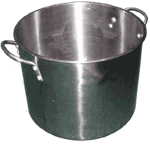
Brew pot
A brew pot is a large stainless steel pot (for 5 gallon extract batches 16-quart is ideal, for 5 gallon all-grain batches 6 to 7 gallon is necessary). You might have a large pot already. Be sure that it is not made of aluminum because it can ruin your beer. You use the brew pot to boil up the wort.
|
|
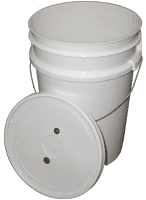
Primary fermenter
Boiled wort is transferred into this vessel for the first phase of fermentation. The primary fermenter must have plenty of headroom (a seven gallon bucket works great), and a lid which seals airtight and accommodates the airlock. Make sure the bucket is made of food-grade plastic.
|
|

Secondary fermenter
This is often a glass carboy. It must be at least as big as your primary fermenter or you will need several; you need to siphon all the liquid from here into your bottling bucket prior to bottling your beer.
|
|

Brew spoon
This spoon is made of stainless steel and should be 18" to 24" long. It doesn’t have to be anything special, just clean; although some brewers have a special attachment to this particular item.
|
|
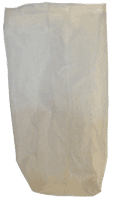
Grain bag
This is a nylon bag designed to hold the grain much like a tea bag holds tea leaves. It’s used for steeping specialty grains that add character to the beer.
|
|
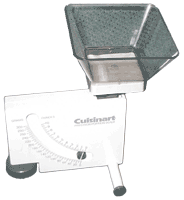
Scale
A scale is necessary for measuring ingredients. Beer recipes are usually given in weights, and even small differences in weight can alter the characteristics of the recipe. The home brew shop always has a scale on hand and can measure the ingredients for you, but it is wise to double check at home. Having a scale also allows you to buy in bulk and measure out your ingredients for several recipes with only one trip to the store.
|
|

Airlock
The airlock allows carbon dioxide to escape during fermentation, so the fermenter doesn't explode, and it prevents contaminated air from entering. It makes cute little noises too if it is the type pictured here. Gives some personality to your fermenting beer.
|
|

Rubber stopper
This provides a way to seal the carboy while allowing a hole for the airlock.
|
|

Hydrometer
This measures specific gravity, which is read before and after fermentation. It is an essential tool for all levels of brewing.
|
|

Thermometer
The thermometer is an important tool during the entire process. Since enzymes and yeast are so picky about the temperature of their environment, this device will help make them happy.
|
|

Plastic hose
This is a food-grade plastic hose. You need it to transfer beer from place to place. It should have a diameter that will allow it to connect to a racking cane and bottle filler with a snug fit. Like everything else it needs to stay clean.
|
|

Racking cane
A racking cane is part of the siphon set up. It is a stiff tube used to draw wort from the bottom of whatever vessel it is used with. It has a cap at the bottom to prevent excessive sediment from entering the siphon while allowing clear beer to flow.
|
|
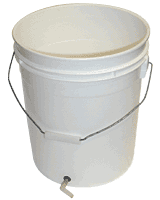
Bottling bucket
Fermented beer is transferred into this vessel to facilitate bottling and to separate the beer from sediment. Priming sugar is added to this vessel to mix with fermented beer for the purpose of natural carbonation in the bottle.
|
|

Bottles
A 5-gallon batch of beer is about 640 ounces, which will fill up to 54 twelve ounce bottles. The bottles must have smooth tops, not twist-off tops, and they should be dark in color. Light damages beer, so you want your bottles to be as dark as possible. The bottles are like sunglasses for your beer.
|
|
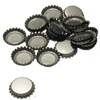
Caps
Unused bottle caps are pressed onto bottles with a bottle capper to seal and maintain pressure. They are sanitized by boiling.
|
|

Bottle filler
Although not necessary, it is very useful and inexpensive. It is attached to the siphon hose during the bottling process.
|
|
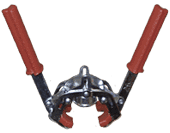
Bottle capper
There are several variations on this device. You will need one unless you are using swing-top type bottles.
|
|
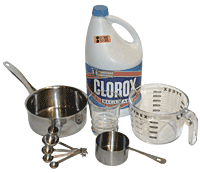
Household items
There will be a few other ordinary household items like bowls, measuring cups and spoons, pots, bleach, and scale.
|
|



















